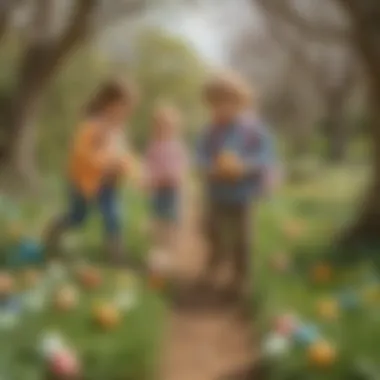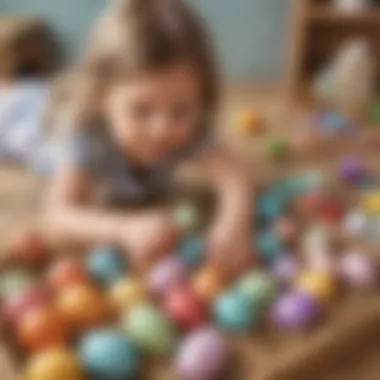Creative Easter Egg Hunt Ideas for Preschoolers


Intro
Easter is a time for exploration, joy, and activity, especially for preschoolers. The traditional egg hunt enriches this festive atmosphere with fun and anticipation. Innovative ideas can elevate this experience into a memorable adventure, sparking creativity and excitement among young children. This article sheds light on unique thematic hunts, educational activities, and ways to create sensory experiences during Easter egg hunts.
By emphasizing collaboration between parents, caregivers, and educators, we develop engaging settings that encourage a better understanding of the event’s meaning. From safety precautions to hands-on planning advice, each section of this guide aspires to make Easter memorable for both children and adults.
Science Fun Facts
Exploring Easter fun can also intersect with learning. Here are some intriguing facts and trivia to lay the groundwork for a captivating egg hunt:
- Egg Structures: The eggs we often use for hunts have diverse structures that serve specific purposes in nature, from protecting a developing chick to ensuring food consistency for everyone participating in the fun.
- Colorful Appearances: Various hues in eggs come from natural pigments. These colors can lead to discussions about plant life and their processes.
Understanding these elements fosters an appreciation for nature within an otherwise festive environment.
- Hunting Habits: Animals use various methods to locate food. Linking these habits to eggs within the hunt allows children to engage with concepts of curiosity and predator-prey relationships.
As we integrate intriguing science concepts, learnings can flow seamlessly into the egg hunt, engaging preschoolers effectively.
Fun Educational Themes
When aiming to connect education and fun during egg hunts, consider implementing themed experiences. These themes provide opportunities to promote learning while ensuring excitement:
- Nature Hunt: Use eggs decorated with different animals or plants. Children learn to identify local wildlife while gathering artifacts along their trajectories.
- Alphabet Adventure: Create eggs featuring the letters of the alphabet. As the child finds an egg, they must say a word that begins with that letter encouraging vocabulary development.
- Sensory Explorer: Utilize materials that evoke different senses; textured eggs can encourage young ones to explore touch or scent.
To maximize the impact of these themes, collaboration among caretakers is essential to planning and executing efficiently.
Planning the Hunt
Proper planning facilitates a seamless egg-hunting experience. Balanced logistics ensure children are engaged while maintaining safety.
- Choosing Locations: Planning indoors or outdoors is critical. Outdoors allows child engagement with the environment, while indoors can be a controlled space safe from potential hazards.
- Age-Appropriate Challenges: Understanding child capabilities is vital. Ensure hideouts are thoughtful, creating excitement without frustration.
- Safety Precautions: Consider the areas and supervise children anrequired, ensuring all necessary steps to keep everyone secure during play, including prohibited zones or reciprocal systems of searching.
One focus during these preparations is to keep activities enjoyable by using the forementioned educational themes to provide additional delight through learning.
Collaborative Activities
Encouraging collaboration between families and educational partners can enhance participating children’s experience. Consider ways to connect these goals effectively:
- Team Play: Divide children into small groups enabling them to search collectively. Promotes teamwork skills while hunting.
- Craft Stations: Before the hunt, establish areas where children can craft their egg-related gear. Doing so instills a sense of contribution to the celebration.
- Story Time: Read stories that connect to Easter traditions and the concept of giving before embarking on the hunt.
Effective communication among parents and teachers results in a richer and substantially safer experience for preschoolers.
Culmination
Implementing these innovative ideas can transform a standard Easter egg hunt into a multifaceted event for preschoolers. By prioritizing learning, safety, and collaboration, adults can introduce little ones to fundamental concepts while establishing memorable holiday experiences. Finding ways to incorporate education into festivities facilitates a deeper appreciation for both tradition and exploration.
Prelims to Easter Egg Hunts
Easter egg hunts are more than just a fun event for children; they are an opportunity to create lasting memories and engage in sensory exploration. This section explores various elements that make up the Easter egg hunt experience, particularly for preschoolers. Engaging young minds through local traditions and cultural significance is crucial. Children thrive on discovery, and Easter egg hunts can ignite curiosity while building essential skills. Moreover, these activities support social interactions, enabling kids to share enthusiasm and celebrate together.
Historical Background
The tradition of Easter egg hunting can be traced back several centuries. Eggs symbolize fertility, rebirth, and renewal across many cultures. The association with the Christian holiday of Easter began in the Christian tradition with the egg symbolizing the resurrection of Jesus Christ. Over time, various secular elements were incorporated, such as decorating eggs and hiding them for search. This evolution influenced many cultures around the world. Local customs often added unique twists to how the egg hunt is conducted today. Understanding this history may enrich the experience and prompt discussions among children.
Importance of Celebrating Easter
Celebrating Easter holds diverse meanings depending upon cultural and religious perspectives. For some, it offers a chance to reflect on spiritual themes or observe family traditions. For others, it represents the arrival of spring and the start of new life. Encouraging preschoolers to participate in celebrations helps them assimilate cultural values. Easter egg hunts also foster community involvement, as families come together to celebrate. Such activities can aim to reinforce conveying values like sharing, teamwork, and joy. Additionally, included activities can serve educational purposes, allowing adults to incorporate lessons that reinforce community culture and history.
"Celebrating holidays such as Easter provides opportunities for young minds to connect with their heritage."
Overall, this section reveals that understanding the historical significance of Easter traditions enhances the experience. This significance can be a jumping-off point for fertile discussions and enjoyable interactions among preschoolers, strengthening bonds and imparting knowledge.
Understanding Preschoolers' Needs
Understanding the unique needs of preschoolers is crucial in crafting successful Easter egg hunts. Young children are in a pivotal stage of their development. They are forming essential skills both cognitively and physically. Acknowledging these elements can provide a more engaging experience during the hunt, and make it beneficial in multiple ways. Involving preschoolers in activities that resonate with their abilities and interests supports their growth while keeping the experience enjoyable.
Cognitive Development Stages
During preschool years, children experience rapid mental growth. Cognitive development includes skills like problem-solving, memory, and the ability to understand concepts. At this stage, toddlers typically grasp simple cause-and-effect ideas. Activities should be designed to pique curiosity without overwhelming future understanding. Incorporating intellectual challenges through Easter egg hunts can engage their interest. Simple puzzles can be hidden in eggs for discovery.


Preschoolers enjoy activities akin to treasure hunts. The thrill of searching fosters their problem-solving skills while making learning enjoyable. When choosing egg hunt tasks, consider:
- Color and Shape Recognition: Use differently colored and shaped eggs to help children learn.
- Basic Counting: Allow children to count how many eggs they have collected. This emphasizes early math skills.
- Story-related Clues: An increase in narrative-based clues assists in enhancing their comprehension and memory.
These activities harness their cognitive potential, making the egg hunt educational while remaining playful.
Physical Coordination Considerations
Physical skills are equally important during preschool years. Coordination, balance, and gross motor skills are developing at a fast rate in this age group. Designing an egg hunt that incorporates movement is essential for both engagement and skill development. Activities such as running, jumping, or crawling challenge their physical capacity.
When thinking about physical ability, here are considerations:
- Distance and Accessibility: Dispersing eggs within reasonable reach promotes participation among all children. Ensure they are not hidden too far away or in difficult spots.
- Varied Motion Requirements: Introduce challenges that require bending, skipping, or even rolling to gather eggs. This diversity keeps the activity exciting and supports physical fitness.
- Team Activities: Organizing group hunts encourages cooperation among children. It enhances social interaction while motivating physical activity together.
By keeping these aspects in mind, the Easter egg hunt can become an avenue for preschoolers to strengthen their coordination skills and foster their physical development.
A well-structured activity can help ground learning experiences fostering both cognitive and physical skills.
Thematic Easter Egg Hunts
Thematic Easter egg hunts contribute significantly to the overall experience of the event. They can turn a regular hunt into an adventure rich in imagination and creativity. Through thematic elements, you can engage preschoolers on multiple levels. Importantly, themes grab attention and foster imaginative play. This encourages children to explore different concepts while still participating in the joy of hunting for eggs.
When planning a thematic hunt, consider both the theme itself and how it interacts with the learning objectives for preschoolers. Themed hunts can affirm key developmental milestones. They encourage cognitive engagement alongside hand-eye coordination as children grasp, and race for the eggs.
Additionally, involving various senses during thematically staged hunts enriches the experience. It invites children to be active participants in a multi-faceted environment — all while observing simple yet rewarding interactions with their surroundings.
Nature Explorations
Exploring nature in an Easter egg hunt atmosphere promotes curiosity and appreciation for the environment. You can use a local park, backyard, or garden as the backdrop for this kind of event. Each egg can symbolize different natural items, animals or elements.
Try to use biodegradable eggs or even paint stones in bright colors. As children search, you can assign points based on themes, like “find the egg near the flower”. Young ones delight in recognizing their surroundings at this stage in life. They can link colors of eggs to flowers — a simple, valuable, and educational skill. This exploration of nature promotes observation skills and environmental awareness.
Color Recognition Activities
A color-themed Easter egg hunt is an effective method to help children strengthen color recognition. Consistent associations between colors and eggs can be more than lively fun. It encourages preschoolers to verbalize colors like red, blue, or yellow while engaging in the hunt. You might use yellow paper to mark egg locations, enticing young explorers to follow a specific hue.
For example, a designated area may hold only blue eggs. Kids can aim to find all blue eggs in one go.
This approach enhances cognitive skills, allowing for easier color differentiation. Sorting through the gathered eggs afterward can supplement the activity through discussion on what colors they found. In this manner, learning is naturally incorporated further, reinforcing preschool education standards actively.
Storybook Themes
Integrating storybook themes into an Easter egg hunt creates a narrative that enlivens the event. Selecting popular children’s stories allows the experience to resonate with familiar content. You might design hunts around tales like “The Very Hungry Caterpillar” or “Goldilocks and the Three Bears”. In this setup, eggs could be hidden as various characters from the book.
For instance, parents hide the eggs in specific locations related to the book's setting. As the children follow clues akin to the story narrative, they enhance both literacy and comprehension skills simultaneously. They engage on a different intellectual level and experience deeper connections to their beloved collaborations. This promotes dialog and storytelling, which is pivotal in preschooler’s development.
Each of these thematic egg hunt ideas supports engagement, education, and joyful connection among peers. It’s a profound reminder that the Easter experience can be both festive and responsible for foundational learning in a child’s earliest years.
Outdoor vs.
Indoor Hunts
The distinction between outdoor and indoor hunts shapes the framework for various Easter egg searching experiences. Each type of setting has its own enhancements and challenges. Accessibility, connivance and engagement level can beneift depending where the activty is organized. Provider focus ensures most nessessary elements are well met, allowing preschoolers to flourish in either scenario.
Planning an Outdoor Hunt
An outdoor hunt takes full advantage of natural spaces. Choose a suitable will-structured location for this activity. Backyards, parks or gardens offer diverse areas that engage not only children but also allow for exploration and play.
When planning, consider age-appropriate tasks. Place eggs in easy-to-reach spots and avoid hidden areas that are too tricky. Involve adults by having them assist children wherever needed. This way, kids can enjoy taking part without stress or loss of confidence.
Engagement with nature can enrich the overall experience. Organize themes, such as a nature treasure hunt, where eggs replaced by small items representing woodland creatures. This can spark curiosity around flora and fauna.
Next, prepare enticing reward eggs. Use clear-color coded eggs or those behaving designated rubber or plastic forms Might help jumping from eggumber to funny sounding prompts like hunting dragon wings to play instruments.
Creating an Indoor Egg Hunt
Indoor egg hunts can be an engaging yet manageable option. Weather-related complications, along with noise control, make these cherry scenarios appealing to many parents. Designing paths for the egg places can captivate the children's minds. Allotted places or creativity-noted scramble routes dictate possibilities like imitating budding flowers.
Ensure to select a safe environment. Prioritize removing objects that could cause injuries like sharp edges. Create a maze using various low furniture types situated to prevent stumbling. Children can relate specified colors to the areas visited, touting completeness in color recognition and profile.
Here’s some potential facets: (It could help convenient.)


- Organizing by room: It’d play significance first through rooms and any special corners aiming at finding nouns like "speed flows."
- Increments: Arrange garment-suit colors based on new voice treats blindly covering aged-tappiaksivi. Each surrounded corner highlights cooperation. Allow one team sharing what germinated choices quiz stimulation supportive habits.
- Intimate personalized prizes hold love to achievement!
Incorporating Sensory Play
Incorporating sensory play into Easter egg hunts offers a rich experience for preschoolers. Young children learn through their senses, and an egg hunt can be a fantastic way to engage multiple sensory modalities. This method not only enhances engagement but also promotes cognitive and motor skill development. With consideration to various senses, activities can be designed to transform a simple hunt into a memorable educational journey.
Using Different Textures
Textures can greatly amplify the tactile experience during an egg hunt. Different textures help children learn about the world through touch. For instance, eggs made of sandpaper, soft fleece, or smooth plastic provides a contrast for little hands to explore. Using textured eggs can expand awareness for preschoolers, enticing them to touch and interact.
Variety in textures furthers a child’s sensory development and curiosity.
- Sandpaper Eggs: Creating eggs with rough sandpaper encourages exploration and curious behavior. When trying to collect or feel them, kids directly engage with what that surface is like.
- Fuzzy Eggs: Cover eggs with fleece or a similar soft material, and allow kids to discover cozy sensations. They can feel warmth during their search.
- Mixed Material Eggs: Use eggs made from mixed materials that brings different sensations altogether. Imagine an egg with a bumpy surface alongside one that is silky. The contrast entre awareness of textures builds comprehension.
These practices not only amuse children but also strengthen fine motor skills as they grasp and manipulate different shapes and surfaces.
Scented Eggs
Incorporating scents into the egg hunt broadens the sensory experience even more. Scent plays a vital role in retaining memories too. Scents enable children to connect with experiences in a deeper way than visuals alone. It sparks interaction and makes collecting eggs much more engaging. Here are some ways to integrate scents into your hunt:
- Essential Oil Eggs: Use eggs infused with toddler-safe essential oils like lavender or orange. Each finds a distinct fragrance, allowing for richer explorations.
- Edible Scented Plastic Eggs: Consider stuffing plastic eggs with items like strongly fragrant herbs such as mint or cinnamon. The scents present during the hunt will influence the children's thoughtful engagement.
- Scent Baskets: Instead of or in addition to scented eggs, create baskets filled with various items such as spices or aromatic plants. The treasure is not only for retrieval but also for exploration.
Scented eggs make the challenge both fun and unforgettable, leaving a lasting imprint on young children. Remember to ensure that all items used are safe for young bodies and tend to minimize any potential allergic reactions. Incorporating sensory play not only enhances the egg hunt itself but instills various sensory abilities in preschool learners.
Educational Elements
Integrating educational elements into Easter egg hunts is vital. It transform this festive activity into a multidimensional learning experience for preschoolers. At this early age, children are in a crucial stage for cognitive and motor skill development. Hence, incorporating simple math skills and science discoveries during the hunt not only makes the event fun but also reinforces the learning they receive in childhood education.
Integrating Simple Math Skills
Easter egg hunts can effectively incorporate simple math skills in various ways. For example, counting eggs, sorting them by colors or sizes, and basic addition can all happen as children engage in the activity. When managing the hunt, organizers can set up stations with different colored eggs. Each station can require specific tasks that involve counting to fill a basket.
For instance, if there are five red eggs at one location, eight blue eggs at another, and three yellow eggs at a different spot, children can be prompted to gather specific counts. This exercise allows kids to practice math in an engaging way. They may even learn early number sense and develop a comfort level with numbers through this approach.
Benefits of Math Integration
- Enhances Critical Thinking: Children begin to think logically as they calculate counts and make decisions.
- Builds Confidence: Success in finding the right number of eggs provides a boost in self-esteem.
- Fosters Social Skills: Interactions during these activities teach sharing and collaboration which are vital at this young age.
Science Discovery through Hunts
Integrating science elements within the hunt ideally leads children's minds to explore fundamental scientific concepts. Not only can they enjoy to find eggs, but you can also help them learn about nature, colors, or even basic physics through different activities planned.
For example, an activity could include placing eggs in various environments—under trees, inside the garden soil, or around flower patches. This could lead to discussions around habitats, life cycles of plants, or even the function of pollinators.
Additionally, simple experiments like observing the different materials comprising the eggs or even using sensitive materials for sensory experiences adds depth. You could add a fun twist by creating "mystery eggs" that contain small science-related items like pine cones or leaves.
Science Discovery Benefits
- Stimulates Curiosity: Children naturally ask questions about their environment, visualizing phenomena that could justify learning.
- Promotes Exploration: Kids engage with the nearby environment, improving their observational skills.
- Encourages Introduction to Conservation: Teaching children about the environment at this age nurtures responsible future perspectives on nature.
By integrating educational elements into Easter egg hunts, families can provide opportunities for learning disguised as play. This is an effective method to enhance both math and scientific literacy among preschoolers.
Environmental Safety Considerations
In planning an Easter egg hunt for preschoolers, ensuring safety is crucial. These young children are naturally curious and often unaware of potential dangers. Therefore, addressing environmental safety considerations allows adults to facilitate a fun and secure experience. This topic encompasses selecting safe locations, understanding possible hazards, and making the right choices in materials used.
Choosing Safe Locations
Selecting the proper location for an Easter egg hunt can greatly influence safety. Ideal options include fenced backyards, parks, or indoor spaces where supervision is optimal. Each of these areas minimizes exposure to risky elements like traffic or unknown animals.
When choosing a venue, consider the following factors:
- Clear Visibility: Ensure that the space to monitor the children is visible from all angles.
- Enclosed Areas: Areas that limit children's ability to wander away provide an assurance of control.
- Known Environment: Locations you are familiar with help avoid unexpected dangers.
It’s wise to inspect the chosen area ahead of time for hazards such as broken glass or sharp objects. Ensuring a clean space is essential to provide a safe hunting environment.
"Safety considerations pave the way for enjoyable experiences."
Egg Materials and Potential Hazards


The materials used for the Easter eggs can contribute to the overall safety of the events. Selecting appropriate materials is important to mitigate risks efficiently. For instance, plastic eggs are a popular choice. Their smooth surfaces and lightweight design reduce the chance of injury.
However, it's vital to consider where these eggs come from and how they are filled. Factors to keep in mind include:
- Choking Hazards: Ensure that any prizes or treats inside the eggs are age-appropriate to eliminate choking risks. Small items should not be included in the eggs, as they can pose serious threats.
- Non-toxic materials: When setting up the eggs, prioritize providing non-toxic, washable items. Avoid strong chemicals and toxic substances when including scents or colors on the eggs.
- Weather-safe items: If utilizing outdoor eggs, ensure they withstand weather changes and won’t create slips or other hazards on wet grass.
Being cautious about these factors ensures that the egg hunt remains enjoyable for preschoolers while minimizing any obstacles that could interfere with their fun. A secure environment encourages participation and happiness, resulting in cherished memories.
Collaboration with Parents and Educators
Collaboration between parents and educators is vital to creating a successful Easter egg hunt for preschoolers. This partnership ensures a well-rounded experience that nurtures creativity and fosters a sense of community. Involving parents enhances solid communication channels and opens opportunities for shared expertise, making planning more effective and enjoyable for everyone. Engaging families in the process not only allows for collective contributions to the hunt's success but also deepens the parents' connection to their children’s learning environment.
Engaging Parents in the Planning Process
Involving parents in the planning stages of the Easter egg hunt can lead to a more enjoyable experience for children. When parents participate, they often add valuable perspectives. For example, they understand their child’s preferences and can suggest themes or activities that resonate most with little ones. Additionally, seeking input from parents helps bring diversity into the hunt itself. Here are a few effective strategies for engagement:
- Start With a Meeting: Host a kickoff meeting to discuss ideas and gather suggestions from families.
- Share Responsibilities: Assign specific roles, like decoration, crafting eggs, or organizing snack stations, to ensure a collaborative spirit.
- Create a Volunteer sign-up sheet: This aids in organizing dedicated helpers for the event.
When parents see their involvement leads to a successful event, they develop a sense of ownership and pride that enhances the preschool community.
Teamwork Among Educators
The role of educators in orchestrating a successful Easter egg hunt is significant, and teamwork plays a central part. Collaborating with colleagues allows educators to share ideas, concerns, and successes and creates a supportive environment that benefits both staff and children. A united approach ensures that everyone is on the same page and working toward common goals. Consider the following aspects of teamwork:
- Brainstorming Sessions: Regularly scheduled meetings among educators encourage creative planning.
- Resource Sharing: Collaborate on materials needed for activities, reducing costs and responsibilities.
- Coordinated Communication: Ensure parents receive consistent messages regarding the event details.
Through collective effort, educators can develop an Easter egg hunt that aligns with educational objectives while keeping the event enjoyable and exciting for preschoolers.
Active engagement between parents and educators fosters a collaborative environment that naturally supports preschoolers’ learning and enhances the Easter celebration.
Integrating parents and educators into the planning and execution of an Easter egg hunt not only improves the overall experience but reinforces educational outcomes as well.
Culminating Celebrations
Culminating celebrations play a key role in any Easter egg hunt, especially for preschoolers. These final moments can create lasting memories. They bring together all the elements of an enjoyable day. This section will dive into vital aspects related to post-hunt activities and discussion avenues.
Post-Hunt Activities
After the excitement of hunting for eggs, engaging in thoughtful post-hunt activities helps children process their experiences. It also allows for celebration of teamwork and individual achievements. Some examples of this could include:
- Crafting Projects: Children can use collected eggs to create art projects. This encourages creativity and hands-on engagement.
- Snack Time: Treating kids to Easter-themed snacks can enhance their enjoyment. Watching children share treats fosters an atmosphere of friendship.
- Story Time: Reading a story about Easter provides an opportunity for relaxation. Themes can revolve around nurturing values or friendship.
It’s crucial to choose activities that match the skills and interests of preschoolers. Keeps things fun while being educational, ensuring every child feels included.
Encouraging Discussion and Reflection
Encouraging discussion and reflection among preschoolers is essential after a fun day of hunting. It strengthens understanding of experiences and feelings. This also offers valuable insights into children’s thoughts. Consider some methods:
- Group Conversations: Invite kids to share their favorite moments. Their joy can be contagious while promoting interacting skills.
- Simple Q&A: Ask questions like, “What was the hardest egg to find?” This engages critical thinking and self-expression.
- Reflection Journals: For older preschoolers, introduction of simple reflection journals could be effective. They can draw or write briefly about their feelings or favorite eggs.
Ultimately, the essence of culminating celebrations lies in fostering connection. These interactions can frame a child's experience in understanding the values of sharing and exploration.
Celebrating small moments forms important memories for young children. These occasions enhance lessons learned during festive events, such as Easter egg hunts.
The combination of meaningful activities and reflection helps as a foundation in preschool development. Creating an inviting atmosphere enables discussion and conversation which supports growth. The overall goal is creating lasting memories and reinforcing positive experiences, making out Easter celebrations memorible.
Epilogue
Celebrating Easter with preschoolers is more than just finding eggs in the grass. It is about creating meaningful experiences that contribute to their growth and development. The ideas presented in this article emphasize a thoughtful approach to designing egg hunts tailored to preschoolers' needs. By considering their cognitive and physical abilities, you can create an event that is both enjoyable and educational.
Recapping the Importance of a Thoughtful Approach
A well-planned egg hunt can foster important skills in young children. When you take a thoughtful approach, you also recognize the desire for sensory engagement and cognitive stimulation. This type of planning ensures children learn while they play. Simple integrations of tasks, such as recognition of colors or sorting eggs, teach preschoolers without overloading them. Here are some vital aspects to keep in mind:
- Safety first: Choosing safe locations and excavating hidden spots.
- Educational fun: Merging math and science elements as enhancement tools to traditional games.
- Creativity in planning: Thematic ideas could also nurture their imagination and curiosity.
"Tailored experiences not only create joy but also cultivate proper skills."
Inspiring Future Celebrations
Looking beyond the current celebration can transform future events into even richer experiences. By innovating each year, you can continually attract the wonder of preschoolers. For instance, consider utilizing community resources. Partnering with local parks or children's organizations can amplify creativity, bringing fresh ideas and themes to your hunts.
Imagine year-on-year improvements, themes rotating between classic stories, or even new adventures in local nature trails. Making adjustments based on feedback from parents and teachers can also lead to remarkable outcomes. The key is fostering a sense of anticipation. Here are a few ideas for future celebrations:
- Seasonal themes: Engaging children throughout the year.
- Family involvement: Strengthening community bonds through collective buying efforts.
- New experiences: Venturing outside the eggs themselves can produce glittering interactions for everyone.
As time passes, these hunts will become cherished memories. The essence of celebrating can grow alongside the children, nurtured through careful planning and inspiration.







